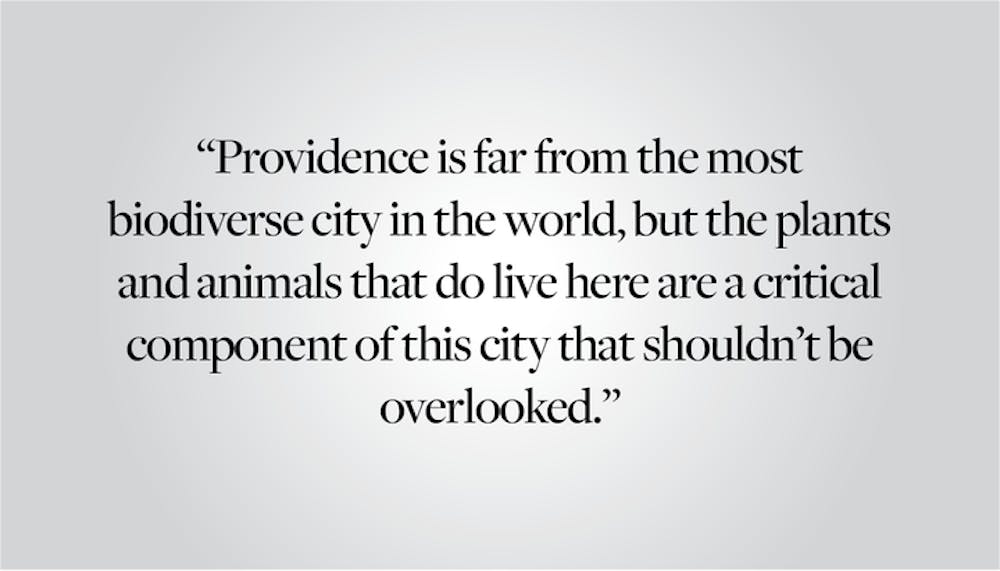Like most college students, my day is filled with walking — to class, the library, the gym and between meals. Having grown up in a car-obsessed suburb, I experienced somewhat of a culture shock in college when I learned I needed to walk everywhere. But I’ve since adjusted and have come to look forward to walking around Providence. I love my morning walks to the gym when the sun is quietly breaking through the maple trees, and my walks to class when I can see white-speckled starlings and orange-breasted robins on the Main Green. During the fall, I’m delighted by the oak, elm and birch leaves that carpet the sidewalks on my way to the library.
When we rush around constantly from classes to meetings and spend our days looking at screens, we miss so much of life’s smaller details, like the hawks that perch on the trees around the Ratty and the delicately serrated edges of elm leaves scattered across campus. Urban beauty is all around us, even if it is not readily apparent. Taking a moment to appreciate Providence’s biodiversity can help us better understand the living things around us and find happiness in the smaller things that usually pass us by in our busy lives.
Though much of Providence County’s original forested lands have been replaced with pavement and residential development, nature continues to thrive in the area. In Blackstone Park, a short walk east of Brown’s campus, birds such as mergansers, black-capped chickadees and Northern cardinals are frequently seen. Seekonk River, which links together the Blackstone River and the Narragansett Bay, has calm waters that provide a resting spot for migratory birds. Watchemoket Cove, which borders the right side of Providence River along the East Bay Bike Path, also hosts calm waters that are home to mute swans and cormorants, black aquatic birds with long, hooked beaks. And red-tailed hawks, American robins and crows can be spotted hopping, skipping and chirping around campus.
Providence’s trees are also greatly varied. Just along Prospect Street are birches, honey locusts, oaks and elms, which brighten autumn with their red and yellow leaves. Some of these trees are so old that their roots have escaped the confines of the sidewalk and created little hills and valleys through the concrete. There are more than a dozen pockets of old growth trees scattered throughout Rhode Island — some of which are hundreds of years old.
From the various animals to the ancient trees, Providence is far from just a collection of buildings and streets. Spending a little more time outdoors when the weather is nice or just paying attention to Providence’s many natural wonders can make all of us a little happier. My friends and I derive lots of entertainment from simply watching the birds in the Providence River paddle around. They have a distinct power hierarchy: swans on top, followed by geese, seahawks, ducks, pigeons and lastly, sparrows. Our joy is backed up by science, too. Regular exposure to nature, even in small doses, has been linked to lower stress, improved mood, lower blood pressure and improved well-being. Even exposure to the sounds of nature can be recuperative compared to the sounds of traffic. When we pay more attention to the living things around us, we tend to pay more attention to ourselves too. A study in England found that those who are more connected with nature have greater senses of contentment and personal growth.
Providence is far from the most biodiverse city in the world, but the plants and animals that do live here are a critical component of this city that shouldn’t be overlooked. The green space that we do have should be cherished, and we all have a responsibility to preserve it so that plants, animals and humans alike can all enjoy it together. Small things like safely picking up litter or planting native seeds help make our environment even better. Buying and using a field identification book of common trees and birds makes it much easier to recognize the species around us, and taking pictures of local fauna and flora can help us appreciate their natural beauty.
It's hard to slow down when we’re always so busy, but it’d be a shame to miss out on the quirks and joys of the plants and animals in the city we all call home.
Juliet Fang ’26 can be reached at juliet_fang@brown.edu. Please send responses to this opinion to letters@browndailyherald.com and other op-eds to opinions@browndailyherald.com.
Juliet Fang is a second year at Brown studying Ecology and Evolutionary Biology. In her free time, she enjoys running, cycling, and watching duck videos.





